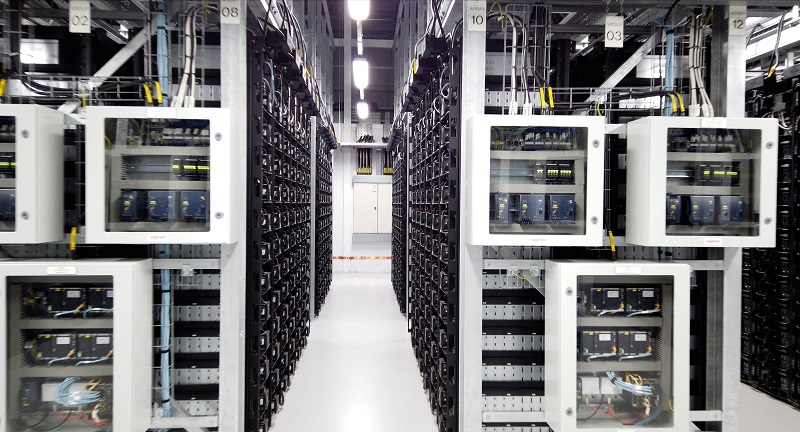Branded Content – The integration of sustainably generated energy into the energy system poses challenges to the grid operator in terms of power quality and availability. Storage of sustainable energy in batteries tackles a large part of the challenges. Energy technology company Centrica offers companies and investors turnkey energy storage and manages to make attractive profits from this as well.
The installed capacity of solar and wind energy assets is already huge, but renewable electricity production will only have to grow faster in the coming years to meet the sustainability targets of the richest seven industrial countries (G7). The International Energy Agency (IEA) has already calculated that in 2022, renewable sources in the G7 countries account for 75 gigawatts of power. However, that number will grow to an impressive 230 gigawatts over the next eight years. This means that, by 2030, the seven economic superpowers will obtain 60% of their electricity supply from renewable sources.
The IEA expects the demand for electricity to increase accordingly over this period. In other words, it will increase by 25% in 2030 and by as much as 80% in 2050, compared to the demand for electricity in 2020. Part of that demand will come from electric cars and electrolyzers for the production of hydrogen. And then many companies will replace their gas-fired plants with electric ones.
Grid quality
Unfortunately, the great growth of renewable decentralised power goes hand in hand with some major challenges. After all, the electricity grid was once designed to transport large coal- and gas-fired power plants to the user. These power plants had the advantage that they could always deliver and always provide the same quality of electricity. Unfortunately, sustainable electricity generation from wind and sun is dependent on supply. The big challenge for grid operators is to bridge the differences between electricity production and consumption and at the same time keep the grid stable. Batteries are playing an increasingly prominent role in this game.
Jeroen Verbeeck of energy technology company Centrica explains how, until now, batteries have supported the grid managers, also known as Transmission Service Operators (TSOs), in keeping their networks in operation. ‘The electricity system is very dynamic and depends on the interaction between supply and demand. The grid operator has a number of instruments to keep its grids in balance, the most important being the frequency containment reserve (FCR) and automatic frequency restoration reserve (aFRR). The former ensures the smoothing of large frequency disturbances on the grid and must be available within thirty seconds. The second is intended more as reserve capacity in case a large power source suddenly fails. In both cases, batteries can offer a solution here. After all, the stored power is quickly available, while the storage capacity has also increased considerably in recent years. In the United States, for example, we already see systems that can supply gigawatts, often for more than an hour.’
Invest in storage
The law does not allow the TSOs to invest in the balance reserves themselves. Instead, they organise auctions on the commercial market. And that market is becoming more and more interesting, according to Verbeeck. ‘In the past, mainly gas-fired installations were used for grid balancing. However, with the current high gas prices, the sparkspread, the difference between the gas and electricity prices, has become extremely negative. This means that the usual backup of gas-fired cogeneration plants is no longer economically interesting. Just compare that with the prices for wind energy, which are sometimes even negative. Those who invest intelligently in storage can therefore benefit from the price fluctuations and supply balancing power to the grid operator on top of that.’
Imbalance market
Now those high gas prices are likely to come down again, but the market has been warned. Major energy consumers will have to think harder about the security of their supply in the longer term. Certainly if they also have to take higher CO2 prices into account. Verbeeck: ‘Power companies are currently investing billions in new wind farms while large industrial users are increasingly replacing gas-fired processes with electric ones. It is therefore expected that the imbalance market will double by 2028. This makes it increasingly interesting for companies or private equity investors to invest in batteries. The only thing they need is a piece of land and capital. Centrica has the necessary knowledge and experience to deploy the assets optimally and to get the most profit out of them. We already do this for companies such as Heidelberg Cement, Sappi, Total and ExxonMobil and in the meantime the business case has only become more interesting. After all, the batteries are becoming cheaper and cheaper. Incidentally, these do not have to be lithium-ion batteries. We are technology-agnostic in our approach and can, for example, also use phosphate batteries if that fits in better with the user profile. An additional advantage of this choice is that these batteries do not need rare materials to function.
Environment friendly
Regardless of the technology, we are generally seeing storage volumes increase while the cost per kilowatt-hour of storage falls. Moreover, companies see it as their social responsibility to stop their emissions and contribute to the energy transition. The objection that lithium-ion batteries also represent an environmental burden no longer applies. There are already companies that can recycle the batteries and the expectation is that suppliers will be obliged to make use of this.
More about Centrica’s energy storage? Click here




